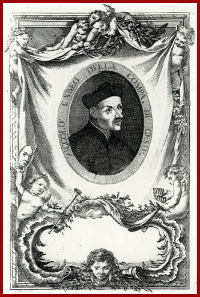Niccolò Cabeo
Niccolò Cabeo , Latinized Nicolaus Cabeus , (born February 26, 1586 in Ferrara , † June 30, 1650 in Genoa ), was an Italian Jesuit , physicist and engineer .
Life
Cabeo entered the Jesuit order as a novice in 1602 and attended the Jesuit college in Parma , where he studied logic, metaphysics , natural philosophy (after Aristotle ) and theology as well as mathematics . After finishing his studies around 1616, he taught theology and philosophy in Parma until 1621 and then for a few years in Ferrara. For some time he served the Dukes of Mantua and Modena as an engineer in various hydraulic engineering projects. At the end of his life he taught again at the Jesuit college in Genoa, where he died.
He published his results in two books. Philosophia Magnetica is dedicated to electricity and magnetism following William Gilbert's De Magnete . In it he contradicts Gilbert's explanation of the earth's magnetism, who thought the earth itself was a large magnet. He undertook experiments on static electricity and explained electrical attraction mechanically through the outflow of a fluid when rubbing, which displaces the surrounding air, which in turn takes lighter charged particles with it when it flows back.
His second work was a commentary on the Meteorology of Aristotle (Physical phenomena in the world on this side of the moon ), which he uses to comment on a variety of topics, including ideas of Galileo Galilei as the Earth's rotation (the Cabeo rejects, he represents a geocentric view of the world ) and free fall (where he undertakes experiments following and confirms Galileo), and alchemical and occult ideas. He also claims to have made experiments on the trajectory (trajectory parabola ) of cannon balls (with positions indicated by holes in paper umbrellas), since Galileo's theoretical treatment was too speculative for him. He also examined the curved shape of a jet of water in the gravitational field. He denied the existence of the vacuum . He was involved in a dispute with the Galileo student Benedetto Castelli about his hydrodynamics theory, which also practically continued in a dispute about the diversion of the Reno River , with Cabeo taking the side of Ferrara and Castelli that of the Pope. He was in correspondence with Giovanni Riccioli and Giovanni Battista Baliani on physical issues.
The moon crater Cabeus is named after him.
Remarks
- ↑ Whereby, as with other experiments, he emphasizes that he had undertaken them in front of witnesses
Fonts
- Philosophia magnetica. Ferrara 1629, Cologne 1629
- In quatuor libros meteorologicorum Aristotelis commentaria. Francisco Corbelletto, Rome 1646, reprint: Rome 1686
literature
- Alfonso Ingegno: Cabeo, Niccolò. In: Dizionario Biografico degli Italiani . Volume 15, Istituto della Enciclopedia Italiana, Rome 1972.
- Peter Dear: Article Niccolò Cabeo. In: Dictionary of Scientific Biography .
- Peter Dear: Discipline and Experience: The Mathematical Way in the Scientific Revolution . University of Chicago Press, Chicago 1995.
- John Heilbron : Electricity in the 17th and 18th Centuries: A Study of Early Modern Physics. University of California Press, Berkeley, Reprinted in Dover 1999
- Carlos Sommervogel: Bibliothèque de la Compagnie de Jésus. Volume 2, Lions 1960.
- Maria Teresa Borgato: Niccolò Cabeo tra teoria ed esperimenti: le leggi del moto. In: GP Brizzi, R. Greci: Gesuiti e Università in Europa. Bologna 2002, pp. 361-385.
- Cesare Maffioli: Out of Galileo: The Science of Waters 1628-1718. Erasmus, Rotterdam 1994.
Web links
- Literature by and about Niccolò Cabeo in the bibliographic database WorldCat
Individual evidence
| personal data | |
|---|---|
| SURNAME | Cabeo, Niccolò |
| ALTERNATIVE NAMES | Cabeus, Nicolaus |
| BRIEF DESCRIPTION | Italian physicist, engineer and Jesuit |
| DATE OF BIRTH | February 26, 1586 |
| PLACE OF BIRTH | Ferrara |
| DATE OF DEATH | June 30, 1650 |
| Place of death | Genoa |
